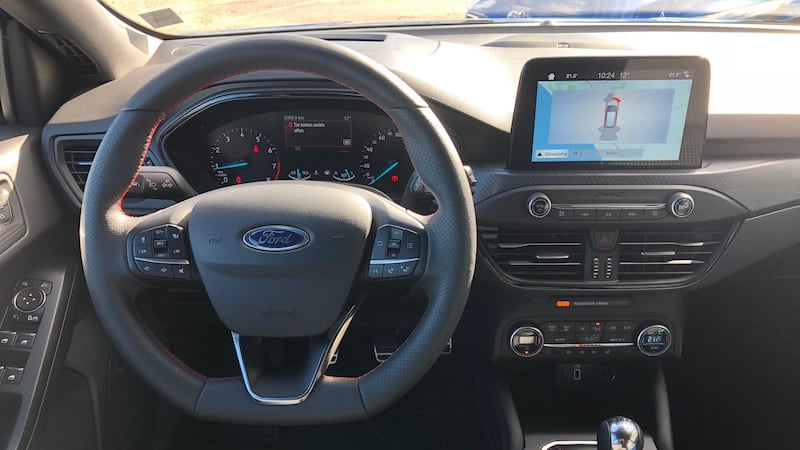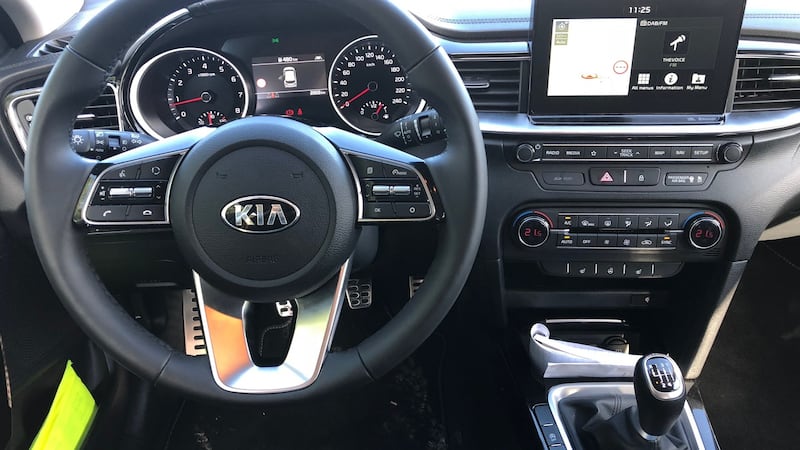For decades the family hatchback format dominated the motoring market. And two models reigned supreme – the Volkswagen Golf and the Ford Focus – cash cows for two car giants. How the world has changed. Now consumer appetite is driven by crossovers and electric powertrains. Hatchbacks seem old hat.
At least that's the perception you get from weeding through the email queries we get in the Motors service pit at The Irish Times. The sales figures tell a different tale. While there's certainly no growth in hatchback sales, it's still a very lucrative segment of the market for both car companies and dealers.
Which brings us to two of the latest revamped arrivals on the market: the new Ford Focus and the recently launched Kia Ceed. One represents the establishment, boasting a well-established name and a reputation for driving fun. The other represents the insurgency, the latest iteration of a wave of models from the Hyundai-Kia family that further secures their position as mainstream brands.
Design
Neither car breaks the mould here, although the Kia tries harder and certainly the latest iteration of its coupe estate derivative, the Proceed, is a bit of a stunner. In a segment of the market that’s relatively conservative and traditional, with only the most gentle evolutions between brands, it’s probably unfair to criticise either too strongly for failing to challenge the conventions. For the styling of the Proceed and its attempt at adding a little spice to the mix, the honour here goes to Kia.

Interior
It’s a world of black plastics in both cabins, with similar layouts right down to the touchscreen central console infotainment systems. In terms of speed of reaction, styling and functions the Ford system has an edge and is more intuitive. Both offer relatively pleasant places to be, though neither is a match for a well-equipped mid-range Golf.
Driving tech
Again both cars are fitted with the latest active and passive safety tech, optional or standard depending on the grades. Both cars were pitted against each other in the well-known elk test – where you have to make a sudden turn to avoid hitting an obstacle in the road, the aforementioned elk – and the Focus came out on top. It was one of the few cars, out of over 50 cars tested, that managed to slip past our cardboard elk at 70km/h. Indeed in progressively faster tests, the ESP stability control didn’t kick in until 65km/h, demonstrating the balance of the car. But it was the Ceed which won out, managing to get around the elk at 75km/h, albeit with a touch of oversteer.
So what does that mean in real life? Well it means the car keeps its cool and can be controlled at speed if and when things go wrong. Both feature automatic emergency braking system that intervene to bring the car to a halt to avoid a collision even if the driver doesn’t react. When put to the test the Focus system worked up to speeds of 60km/h, the Ceed to speeds of 45km/h, although Kia has said there may have been an issue with the test car, so it should operate to a higher speed.

On the road
The Focus is building on a very firm foundation. It might not have the best cabin in its class, nor offer the highest level of refinement – those honours undoubtedly go to the VW Golf – but it is always the most engaging hatchback to drive. It encourages even the most genteel motorist to tread lightly on the brake pedal when approaching a set of bends, reassuringly weaving its way through them like it is on rails.
The Kia is notably sharper than its predecessor and the addition of a multilink rear suspension makes a real difference to the car’s handling on rural roads. It’s a lot more poised than before. Yet, throw some real Irish rough surfacing at it and the Focus has a very clear edge over the Ceed.
Engines
Our test was between the 1.4-litre 140bhp petrol Ceed and the 1.5-litre EcoBoost 175bhp Focus, so the American was always going to have an edge. Yet, even with that front and centre in our minds during testing, it was not about straight out power but rather solid mechanical performance that made the Focus stand out. From the transmission and the smooth, solid changes of the six-speed manual transmission to the linear feed of the throttle response, the Focus just felt the better car. The Ceed was impressive, but always felt a little softer, both in terms of throttle and gearchange.
Pricing
The Ceed starts at €22,695 for the surprisingly impressive little 1-litre petrol, rising to €28,695 for the 1.4-litre as tested. A 1.6-litre diesel starts at €26,875 and while it delivers on fuel economy it remains a little rough around the edges.
The Focus, meanwhile, starts at €22,495 for its star turn, the 1-litre Ecoboost petrol. A 1.5-litre diesel starts at €24,368. That's all Ford in Ireland is offering for now in terms of engines, which is a shame, for the bigger engines get the firm's better underpinnings, such as multilink rear suspension. By foregoing these models the company is signalling a decision to surrender its position as the best-driving car in its class. And that opens the door to rivals like Kia Ceed, Hyundai i30 and long-term arch-rival the Golf.
Overall
Despite the improvements with the Ceed, and the surrender by Ford, we’d still lean towards the Focus, but by a much tighter margin than before. Ford’s 1-litre is a little sharper, its handling a little crisper and the mechanics a little more responsive.
For those who aren’t rushing to join the crossover cavalcade, these are two very tempting hatchbacks. Perhaps the ultimate answer is that you’d end up opting for a Golf.






















